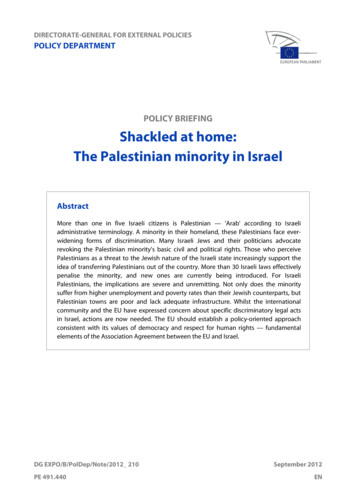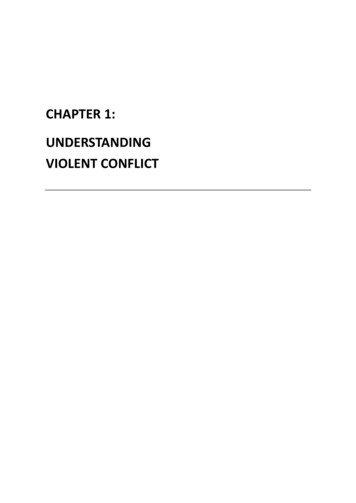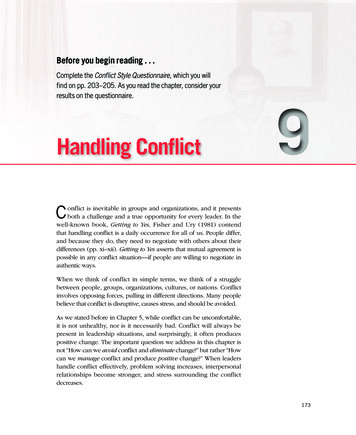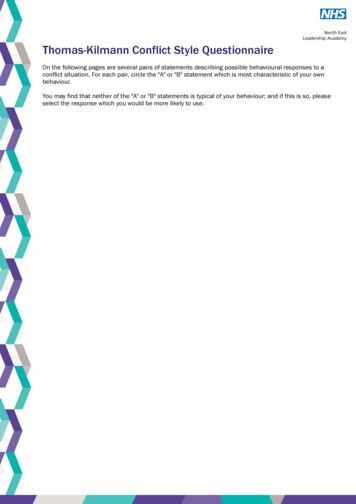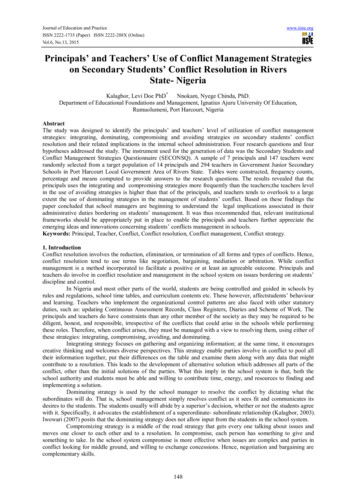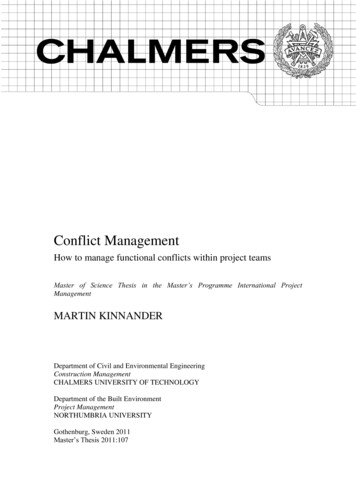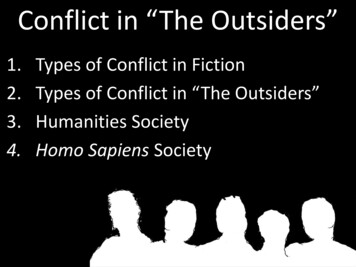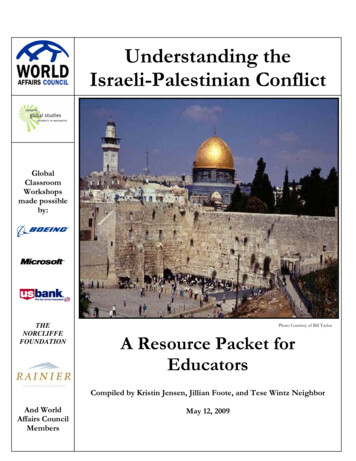
Transcription
Understanding theIsraeli-Palestinian ConflictGlobalClassroomWorkshopsmade possibleby:THENORCLIFFEFOUNDATIONPhoto Courtesy of Bill TaylorA Resource Packet forEducatorsCompiled by Kristin Jensen, Jillian Foote, and Tese Wintz NeighborAnd WorldAffairs CouncilMembersMay 12, 2009
HOW TO USE THIS RESOURCE GUIDEPlease note: many descriptions were excerpted directly from the websites.Packet published: 5/11/2009; Websites checked: 5/11/2009Recommended ResourcesLinks that include Lesson Plans &Teacher ResourcesCharts & GraphsAudioVideoPhotos & SlideshowsMapsTABLE OF CONTENTSMAPS1FACT SHEET3TIMELINES OF THE CONFLICT4GENERAL RESOURCES ON THE ISRAELI-PALESTINIAN CONFLICT5TOPICS OF INTERESTCURRENT ARTICLES/EDITORIALS ON THE ISRAELI-PALESTINIAN CONFLICT(Focus on International Policy and Peace-Making)78THE CRISIS IN GAZA9RIPPED FROM THE HEADLINES: WEEK OF MAY 4TH10RELATED REGIONAL ISSUES11PROPOSED SOLUTIONS13ONE-STATE SOLUTION14TWO-STATE SOLUTION14THE OVERLAPPING CONUNDRUM – THE SETTLEMENTS15CONFLICT RESOLUTION TEACHER RESOURCES15MEDIA LITERACY17NEWS SOURCES FROM THE MIDEAST18NGOS INVOLVED IN ISRAELI-PALESTINIAN RELATIONS20LOCAL ORGANIZATIONS & RESOURCES22DOCUMENTARIES & FILMS24BOOKS29
MAPShttp://johomaps.com/as/mideast.html & k/geos/is.htmlOther excellent sources for maps:From the Jewish Virtual Library - y/maptoc.htmlFoundation for Middle East Peace - http://www.fmep.org/maps/ OR http://www.fmep.org/maps/all-mapsIntegrated Regional Information Networks - http://www.irinnews.org/maps.aspx1
Source: BBC http://news.bbc.co.uk/2/hi/middle east/5122404.stmSource: CIA World heworld-factbook/geos/is.htmlSource: CIA World he-world-factbook/geos/we.html2
FACT SHEETSource: CIA World FactbookISRAELWEST BANKGAZA STRIPUNITED STATESArea - Comparativeslightly smaller than NewJerseyslightly smaller thanDelawareslightly more than 2xWashington, DCSimilar to China; more than 2xthe EUNatural Resourcestimber, potash, copper ore,natural gas, phosphate rock,magnesium bromide, clays,sandarable landarable land, natural gascoal, copper, lead, phosphates,uranium, bauxite, gold, iron,mercury, nickel, potash, silver,tungsten, zinc, petroleum,natural gas, timberLand Usearable land: 15.45%permanent crops: 3.88%other: 80.67% (2005)arable land: 16.9%permanent crops: 18.97%other: 64.13% (2001)arable land: 29%permanent crops: 21%other: 50% (2002)arable land: 18.01%permanent crops: 0.21%other: 81.78% (2005)Renewable WaterResources1.7 cu km (2001)no datano data3,069 cu km (1985)Population7,233,701note: includes about 187,000Israeli settlers in West Bank,20,000 in the Israeli-occupiedGolan Heights, & 177,000 inEast Jerusalem (2009)2,461,267note: in addition, there areabout 187,000 Israelisettlers in the West Bankand fewer than 177,000in East Jerusalem (2009)1,551,859 (July 2009)307,212,123 (2009)Population Growth1.671% (2009)2.178% (2009)3.349% (2009 est.)0.975% (2009 est.)82% of total pop. (2008)Urban Population92% of total pop. (2008)72% of total pop. (2008)72% of total pop. (2008)Life expectancy at Birthtotal population: 80.73 yrstotal population: 74.54 yrstotal population: 73.42 yrstotal population: 78.11 yrsEthnic GroupsJewish 76.4% (Israel-born67.1%, Europe/Americaborn 22.6%, Africa-born5.9%, Asia-born 4.2%), nonJewish 23.6% (mostly Arab)(2004)Palestinian Arab andother 83%, Jewish 17%Palestinian Arabwhite 79.96%, black 12.85%,Asian 4.43%, Amerindian andAlaska native 0.97%, nativeHawaiian and other Pacificislander 0.18%, two or moreraces 1.61% (2007)ReligionJewish 76.4%, Muslim 16%,Arab Christians 1.7%, otherChristian 0.4%, Druze 1.6%,unspecified 3.9% (2004)Muslim 75%(predominantly Sunni),Jewish 17%, Christian &other 8%Muslim (predominantlySunni) 99.3%, Christian0.7%Protestant 51.3%, RomanCatholic 23.9%, Mormon 1.7%,other Christian 1.6%, Jewish1.7%, Buddhist 0.7%, Muslim0.6%, other 2.5%, unaffiliated12.1%, none 4% (2007)Literacytotal population: 97.1%male: 98.5%female: 95.9% (2004)total population: 92.4%male: 96.7%female: 88% (2004)total population: 92.4%male: 96.7%female: 88% (2004)total population: 99%male: 99%female: 99% (2003)Government Typeparliamentary n-based federalrepublicSuffrage18 y.o.; universalno datano data18 y.o.; universalGDP per capita (PPP) 28,200 (2008) 2,900 (2008) 2,900 (2008 est.) 47,000 (2008)Unemployment6.1% (2008)16.3% (June 2008)41.3% (June 2008)7.2% (Dec. 2008)Military Service Age andObligation18 y.o. for compulsory (Jews,Druzes) & voluntary(Christians, Muslims,Circassians) service; bothsexes (2008)In accordance with peaceagreement; not permittedconventional militaryforces (2008)In accordance withpeace agreement; notpermitted conventionalmilitary forces (2008)18 years of age (17 years of agewith parental consent) for maleand female voluntary serviceRefugees and InternallyDisplaced PersonsIDPs: 150,000-420,000 (Arabvillagers displaced fromhomes in northern Israel)(2007)refugees (country oforigin): 722,000(Palestinian Refugees(UNRWA)) (2007)refugees: 1.017 million(Palestinian Refugees(UNRWA)) (2007)refugees: U.S. admitted 62,643during 04/05; 10,586 (Somalia);8,549 (Laos); 6,666 (Russia);6,479 (Cuba); 3,100 (Haiti);2,136 (Iran) (2006)3
“Peace cannot be achieved through violence; it can only be attainedthrough understanding.”Ralph Waldo EmersonWe all know there are two sides to any argument, but the key to discussing real prospectsfor peace is by truly understanding the other side’s opinions, perspectives, and concernswithout using volatile language, demonizing your adversary, or unfairly dominating thedebate. Keeping an open mind and open ear can be extremely difficult when it comes tocontroversial topics, such as the Israel-Palestine conflict, but no solution will ever succeedunless we all try to step outside of our comfort zones and listen to opinions and ideas wemay not agree with. We might then discover common ground we would not have found ifthe discussion had not taken place, and it can start with one person, one idea, onediscussion, one acknowledgement, justone.TIMELINES OF THE CONFLICTBelow are links to timelines of the history of the Arab-Israeli conflict. Please be aware that any timeline is fraught withdangers. Israelis, Arabs, and Palestinians would develop very different timelines. Each would include events thatwould not be included on the others' timelines. And each would provide very different descriptions for events they allinclude. Therefore, it is important to consult a number of different timelines to get a sense of which events thevarious groups consider important and how they understand those events.- Professor Bill TaylorA HISTORY OF THE ISRAELI-PALESTINIAN CONFLICT – PROMISES PBS ises-timeline.pdfThe history of the Palestinian-Israeli conflict is elastic; it changes dramatically depending on who is telling it andwhere they start the story. Therefore, it is important to note that a historic timeline of events concerning this conflictis always difficult to present in an objective manner. For this reason, as you read through the Timeline sections,certain events include both a Palestinian (in green) and an Israeli (in blue) perspective. To explore the Timeline, clickone of the four highlighted sections: 1880-1936, 1947-1973, 1974-1988 or 1991-2001. The information on the Israeli perspective wasput together using the Israeli Government’s official Web site, produced by Israel’s Ministry of Foreign Affairs. Information on the Palestinian perspective was compiledusing the Palestinian National Authority’s official Web site and the Palestinian National Authority’s Ministry of Information’s Web site.Other History Sites:The Israeli-Palestinian conflict in a nutshell – MidEast Web /Israeli-Palestinian Conflict Timeline 1967-2007 – The Foundation for Middle East ine.htmlIsrael Factsheet – The Economist cfm?folder Profile-FactSheetMideast Crisis – BBChttp://news.bbc.co.uk/2/hi/in depth/middle east/2001/israel and the palestinians/default.stm4
GENERAL RESOURCES ON ISRAELI-PALESTINIAN CONFLICT“More than ever before in human history, we share a common destiny. We can master it only if we face it together.”Kofi AnnanTEN THINGS STUDENTS NEED TO KNOW ABOUT THE ORIGINS OF ISRAEL AND PALESTINE (April enberg.originsisraelpalestine.htmlAs the sixtieth anniversary of Israel’s independence in May 2008 approaches, that country remains a focal point ofworld attention, as it has been since its birth. The state’s origins do much to explain why the Arab-Israeli conflict hasbeen so hard to resolve, but also provides a glimpse of the possibilities of peace. Here are ten things for students toknow, along with ten things for them to g/Israeli-Palestinian ProCon.org presents statistics, maps, timelines, historical documents, photos, and pro and constatements on questions related to the Israeli-Palestinian conflict. For the best overview of the website, start with thethree boxes on the main page entitled: 1-Minute Overview, Top 10 Pros and Cons, and fun facts in Did You Know?SHIFTING SANDS: BALANCING U.S. INTERESTS IN THE MIDDLE EAST – CHOICES php?id 24The Choices Curriculum for the 21st Century Education Program is a national education initiative based at BrownUniversity's Watson Institute for International Studies. This unit allows students to examine the Arab-Israeli conflict,the role of oil in geopolitics, the politicization of Islam, the significance of the Iranian Revolution, and other historicalissues that have shaped U.S. ties to the Middle East. ( 16 download teacher’s set; 20 reproducible text, one teacher'sguide.)ARAB-ISRAELI CONFLICT: PRIMARY SOURCE DOCUMENTS/THE CONFLICT/THE net/Arab-Israeli Conflict.htmAlthough this site has not been updated since 2005, it provides access to a wealth of primary and secondary sourcedocuments about the Arab-Israeli conflict, ranging from the history of the conflict, to articles and opinions from boththe Israeli and the Palestinian perspectives. (Primary source documents date from 1130 to 2005)A HISTORY OF CONFLICT: ISRAEL AND THE PALESTINIANShttp://news.bbc.co.uk/2/hi/in depth/middle east/2001/israel and the palestinians/default.stmBBC News Online highlights some of the key dates of recent Middle East history and looks back at the origins anddevelopment of the Arab-Israeli conflict. It also provides links to current events stories on the conflict, video reports,and a variety of maps illustrating the conflict. It includes articles focusing on obstacles to peace including: Jerusalem;Borders and Settlements; Water; Refugees; and History of Failed Peace Talks.20TH CENTURY MIDDLE EAST CONFLICT – 0thCentury MiddleEast.shtml#lessonExcellent educational source for activities, lesson plans, extensive historical information, links, and more.COUNTRY BRIEFINGS: ISRAEL – THE /The Economist magazine online provides links to recent articles on Israel, a country profile, and lists relevant websites.ISRAEL AND THE PALESTINIANS – THE sBySubject/display.cfm?id 348984This site provides links to articles and other news on the Israel and Palestine debate.5
RELIGION, IDENTITY, AND MIDEAST PEACE – FOREIGN POLICY RESEARCH ion.rosen.religionidentitymideastpeace.htmlThis Tenth Annual Templeton Lecture on Religion and World Affairs was given by Rabbi David Rosen (director ofInter-religious Affairs for the American Jewish Committee in Jerusalem) in Sept., 2005. He discusses the issues ofreligion and identity in the Middle East, most notably Israel and Palestine. This is a discussion about the role thatreligion plays in the Israel-Palestine conflict and some peace movements between religious groups. Rabbi Rosenconcludes, “Simply stated, if we do not want religion to be part of the problem, it has to be part of the solution—andwhere else more so than in the land that is holy and so significant for all three faiths, and where any accord betweenthe local communities will have enormous ramifications not only for our region but indeed for the world as a whole.”The article is probably heavy reading for middle-school, but could certainly be used at the high school level or adapted for use at all levels.ISRAEL AND PALESTINE: THE FIGHT FOR ams/ispal peaceThe objectives of this high school lesson plan include: the student will research the history of the peace process andwrite a paper about the Israeli-Palestinian conflict. Set the stage for the lesson by showing students the video Israel andPalestine: The Fight for Peace (link to this video found within).CRISIS GUIDE: THE ISRAELI-PALESTINIAN CONFLICT – COUNCIL ON FOREIGN RELATIONS ive timeline, detailed map, highlights of the diplomatic milestones, descriptions of all main players, and links tofurther resources. There is also narration for each slide and a short quiz you can take to test your knowledge.QUESTION OF PALESTINE – UNITED This web site is maintained by the Division for Palestinian Rights at the United Nations and contains history,multimedia, links, updated news and current events, resolutions, and much more.BACKGROUND NOTE: ISRAEL – U.S. DEPT OF ains information on geography, people, politics, economics, foreign relations, basic facts, etc.ISRAEL, THE WEST BANK AND GAZA: COUNTRY SPECIFIC INFORMATIONhttp://travel.state.gov/travel/cis pa tw/cis/cis 1064.htmlISRAEL RESOURCES – COLUMBIA UNIVERSITY MIDDLE EAST st/cuvlm/Israel.htmlColumbia University’s collection of Israel Internet Resources is an on-going compilation of electronic bibliographicresources and research materials, created under the purview of the Middle East Studies Department.PALESTINE east/cuvlm/Palestine .htmlISRAEL – ENCYCLOPEDIA c/296740/IsraelInformation on the land, people, history, etc. from the free online version of the Encyclopedia ecked/topic/439645/PalestineEXPLORING CONFLICT BETWEEN ISRAEL, HEZBOLLAH, AND THE COUNTRIES THAT SUPPORT THEM sons/20060719wednesday.htmlIn this lesson, students will explore the conflict between Israel and Hezbollah. They will then research variousperspectives, discuss the events in context, and write statements from the perspective of a country or organizationinvolved.6
A COUNTRY STUDY: ISRAEL – U.S. LIBRARY OF e its predecessor, this study is an attempt to treat in a concise and objective manner the dominant social, political,economic, and military aspects of contemporary Israeli society. Sources of information include scholarly journals andmonographs, official reports of governments and international organizations, foreign and domestic newspapers, andnumerous periodicals. Chapter bibliographies appear at the end of the book; brief comments on some of the morevaluable sources suggested as possible further reading appear at the end of each chapter.THE MIDEAST: A CENTURY OF CONFLICT: A SEVEN-PART SERIES TRACES THE ISRAELI-PALESTINIANDISPUTE (Sept. ory/NPR presents this special series on the roots of the Israeli-Palestinian conflict to bring context and perspective to thestory, and to help listeners understand the complex situation in the Mideast, the history, and the consequences of theconfrontation. To accomplish this, NPR has gone to leading historians of the region to document the deep andconflicting roots of today's Middle East.TOPICS OF INTERESTHAMAS – CFRhttp://www.cfr.org/publication/8968/What is Hamas? What are Hamas’s origins? Who are Hamas’s leaders? These, and many other questions, areanswered on CFR’s Backgrounder Guide on Hamas. Also found here are links to related materials on the CFRdatabase.ISRAEL’S BARRIER – rier/index.htmlThis four-part multimedia series explores how the barrier has affected the lives of those who live there today -profiling workers, businessmen, settlers, and soldiers. It introduces Palestinian laborers, farmers, small-businessowners, and school kids who, daily, have to navigate the barrier and its checkpoints to get to work and school -- andto see family and friends. It also looks at Jewish settlers who have mixed feelings about the barrier and who want tobe included in the route of the controversial project. And it profiles other settlers who were left on the "wrong" sideof the wall who now want to leave the West Bank -- if compensated by the government. The series captures therealities of life along the barrier, including the struggles of the people who find good and bad in it everyday.U.S. FOREIGN AID TO ISRAEL – CRS & is report provides an overview of U.S. foreign assistance to Israel. It includes a review of past aid programs, data onannual assistance figures, and an analysis of current issues. The report will be updated annually to reflectdevelopments over the previous year.BUDGET SUMMARY: ISRAEL – e/il.html“The close bilateral relationship that the United States has with Israel serves the national security interests ofboth countries. The Government of Israel's (GOI) political and economic stability continues to be a keyobjective of U.S. foreign policy in the Middle East.”7
CURRENT ARTICLES/EDITORIALS ON THE ISRAELI-PALESTINIAN CONFLICT(Focus on International Policy and Peace-Making)KING: CORE MIDDLE EAST PROBLEM MUST BE RESOLVED – NPR (April storyId 103354609In an interview with NPR, King Abdullah of Jordan said he thinks the new approach will be to try to restart IsraeliPalestinian talks and, simultaneously, to work on the Israeli-Lebanese and Israeli-Syrian tracks. The ultimate "prize"for the Israelis, King Abdullah said, is recognition by the 57 Arab and Muslim nations that don't have relations withthe Jewish state. He says Israel is at a critical juncture now and has to decide whether it wants to be "integrated intothe neighborhood" or continue to be "fortress Israel."CLINTON’S MIDEAST PIROUETTE – NYT (April 27, htedcohen.html? r 1&scp 1&sq Clinton's%20Mideast%20Pirouette%20&st cseThe criticism of the center-right government of Prime Minister Benjamin Netanyahu has come from an unlikelysource: Secretary of State Hillary Clinton. She’s transitioned with aplomb from the calculation of her interests that shemade as a senator from New York to a cool assessment of U.S. interests. These do not always coincide with Israel’s.NEW POLICIES AND OLD REALITIES IN THE MIDDLE EAST (Jan. ewoldmiddleeast.htmlPodcast: uspolicymiddleeast.htmlThis essay by Harvey Sicherman, President of FPRI and a former aide to three U.S. secretaries of state, is based on histalk given December 11, 2008. “Let me begin by noting that the U.S. literature on American policy in the Middle Eastis hypercritical. In reading it, one could conclude that the sky is falling down or that the sky will fall down tomorrowor that it fell down yesterday, but Washington is too dense to understand it. I propose that, although we have failed toreach our ultimate goals, we have come a very long way and quite successfully. Since 1948, all U.S. administrationshave eventually settled on three vital American interests: (1) access to oil at a tolerable price, (2) the security of theState of Israel, and (3) preventing the region from coming under the domination of a hostile power.”A REAL PRO-ISRAEL POLICY HELPS PALESTINIANS, TOO – YES! (2008)http://www.yesmagazine.org/article.asp?ID 2683The Israel-Palestine conflict isn’t inevitable. Here’s how both sides could gain by building on their common interestfor peace and fairness. The United States still holds the key. Peace between Israelis and Palestinians is possible—Israeli security and Palestinian rights are not mutually exclusive, but rather each is impossible without the other.PALESTINE’S HOLOCAUST MUSEUM – AL JAZEERA (April 30, 09429133130101883.htmlIn a small anonymous home in the West Bank, a Palestinian academic has set up a project which is almost unheard ofin the Occupied Territories. Hassan Musa is the curator of a museum exhibition dedicated to the Jewish Holocaust inEurope.A STIMULUS PACKAGE FOR REVIVING THE PEACE PROCESS – WEATHERHEAD CENTER FORINTERNATIONAL AFFAIRS HARVARD UNIVERSITY (Feb. 2009)http://www.wcfia.harvard.edu/node/4637The recently enacted stimulus package for reviving the worst U.S. economic recession in decades should serve as amodel for reviving the Palestinian-Israeli peace process. The peace process has been in its own recession since thefailure of the Taba talks in January 2001. The steady expansion of Israeli settlements in the West Bank has deepenedthat recession. By all accounts, Israeli settlements block the implementation of a two-state solution to the PalestinianIsraeli dispute. The stimulus package should consist of a multi-billion dollar international fund with a first priority ofreversing the growth of Israeli settlements and financing the resettlement of Israelis from the West Bank essentiallywithin the 1967 borderrs.8
ABRAHAMIC ALTERNATIVES TO WAR: JEWISH, CHRISTIAN, AND MUSLIM PERSPECTIVES ON JUSTPEACEMAKING – USIP (Oct. .htmlEight Muslim, eight Christian, and six Jewish scholars and leaders met from June 13 to 15, 2007, in N.Y., at aconference sponsored by the United States Institute of Peace and the Churches’ Center for Theology and PublicPolicy. The purpose of the conference was to specify practices within each of the three Abrahamic traditions thatcould lay the groundwork for a nonviolent program to resolve global conflict and address injustice.THE CRISIS IN GAZATHE GAZA CRISIS: KEY MAPS AND TIMELINES – BBC (2008)http://news.bbc.co.uk/2/hi/middle east/5122404.stmA day-by-day account of violence in Gaza and Israel since the offensive began on 27 December 2008.ENDING THE WAR IN GAZA - MIDDLE EAST BRIEFING – INTERNATIONAL CRISIS GROUP (Jan. 2009)http://www.crisisgroup.org/home/index.cfm?id 5838&l 1The six-month ceasefire that expired on 19 December was far from ideal. Israel suffered through periodic rocket fireand the knowledge that its foe was amassing lethal firepower. Hamas endured a punishing economic blockade,undermining its hopes of ruling Gaza. A sensible compromise, entailing an end to rocket launches and an opening ofthe crossings should have been available. Without bilateral engagement, effective third party mediation or mutualtrust, it inexorably came to this: a brutal military operation in which both feel they have something to gain.AN ISRAELI PLAYGROUND, FORTIFIED AGAINST ROCKETS – NYT (March 11, eeast/12israel.html? r 1&fta yA year ago, as Hamas rockets from Gaza rained down almost daily on this Israeli border town, Stanley M. Chesley,president of the Jewish National Fund, was on a solidarity visit here and realized that he saw no children playingoutdoors. It was too dangerous.GAZA CONFLICT: DETERRENCE AND THE OTHER MISSED POINTS (Jan. nflict.htmlMichael Radu, co-Chair of FPRI’s Center on Terrorism, Conterterrorism, and Homeland Security discusses histhoughts on the Gaza conflict. The Israeli government, through Prime Minister Olmert, foreign minister Livni, or defense ministerBarak, seems to agree that Israel’s goal for the ongoing Cast Lead operation is to deter Hamas from continuing its campaign of regularmissile bombings of southern and central Israel. If they mean it - and that is still unclear - they are dangerously misguided and misleadingtheir public. Moreover, they are sending Israeli soldiers to their deaths for an illusory goal.FOCUS ON GAZA – AL JAZEERA (April 30, ongaza/REBUILDING ngaza/2009/04/2009421121334638912.htmlIsrael's war on Gaza left 4,000 homes destroyed and 17,000 damaged. Schools, hospitals, police stations, eventhe parliament building all need to be rebuilt.RESTRUCTURING GAZA: LESSONS FROM LEBANON – USIP (March 2009)http://www.usip.org/pubs/usipeace briefings/2009/0309 reconstructing gaza.htmlReconstructing Gaza – Lessons from Lebanon: argues that donors should avoid the temptation to adopt a mechanistic, onesize fits all solution. "In the rush to rebuild what was destroyed, it should be remembered," writes Harris, "that themajor catalysts for this conflict were political and economic. As such, the reconstruction effort must ensure that viableemployment initiatives form part of the post-conflict stabilization plan.” During this man-made humanitarian disaster,"if the underlying issues are not addressed, unfortunately renewed conflict would seem inevitable."9
ACTIVISTS SEEK PEACE IN GAZA – YES! (2009)http://yesmagazine.org/article.asp?ID 3305In the wake of the death and destruction that resulted from the Israeli assault on the Gaza Strip, there is a positivestory that has received little attention: People of conscience from around the world are organizing to support humanrights in Palestine. While there has been little sympathy in the international community for the extremist Hamasorganization that came to power in the crowded Palestinian territory a year and a half ago, there has been widespreadrecognition that Palestine’s civilian population should not be subjected to massacre. More than 1,300 Palestinians,close to half of whom were civilians, died during the Israeli assault in December and January, compared to 13 Israelis(three civilians).ISRAELI SOLDIERS REFUSE TO SERVE IN GAZAhttp://www.yesmagazine.org/article.asp?id 3240At a January 8th, 2009 protest in Tel Aviv, conscientious objectors speak out.R IPPED FROM THE HEADLINES:WEEK OF MAY 4THUN EXPERTS DISCUSS GAZA MISSION – BBC (May 4, 2009)http://news.bbc.co.uk/2/hi/middle east/8032245.stmUN investigators are beginning a week-long meeting in Geneva, ahead of a mission to Israel and the Gaza Strip. Theteam is mandated to investigate possible war crimes committed by Israel and Hamas last December and January.ADDRESSING U.S., HAMAS SAYS IT GROUNDED ROCKETS – NYT (May 4, eeast/05meshal.htmlThe leader of the militant Palestinian group Hamas said that its fighters had stopped firing rockets at Israel for now.He also reached out in a limited way to the Obama administration and others in the West, saying the movement wasseeking a state only in the areas Israel won in 1967.ISRAEL SAYS SECURITY VITAL TO PEACE – AL JAZEERA (May 5, 2009/05/200955745385707.htmlThe Israeli prime minister has said his government wants peace, but not at the cost of Israeli security.ISRAEL PM MOOTS ‘FRESH’ APPROACH – BBC (May 5, 2009)http://news.bbc.co.uk/2/hi/middle east/8033827.stmThe Israeli prime minister has said he is willing to resume peace talks with Palestinians without delay or preconditions.U.S.: ISRAEL MUST BACK TWO-STATE DEAL – AL JAZEERA (May 6, 09/05/20095516263485870.htmlJoe Biden, the U.S. vice-president, has said that Israel should back a two-state peace agreement and stop constructingnew Israeli settlements on occupied land.UP FOR DISCUSSION – THE ECONOMIST (May 6, /displaystory.cfm?story id 13605611America and Israel lay the ground for forthcoming talks.UN BLAMES ISRAEL FOR GAZA ATTACKS – AL JAZEERA (May 6, 09/05/200955143232389149.htmlA United Nations inquiry into the war in Gaza has found that Israel was to blame for at least seven direct attacks onUN operations - including schools and medical centers.10
FM LIBERMAN MEETS WITH GERMAN FM STEINMEIER – ISRAEL MINISTRY OF FOREIGN AFFAIRS (May 8,2009)http://www.mfa.gov.il/MFA/About the Ministry/MFA Spokesman/2009/Press r-8-May-2009.htmFM Liberman requested German support at the forthcoming meeting of the European Council on the upgrading ofthe European Union’s relationship with Israel without linkage to the Palestinian issue.PARKS FORTIFY ISRAEL’S CLAIM TO JERUSALEM – NYT (May 9, eeast/10jerusalem.html?ref worldIsrael is quietly carrying out a 100 million, multiyear development plan in some of the most significant religious andnational heritage sites near the walled Old City as part of an effort to strengthen the status of Jerusalem as its capital.IN U.S., A CHANGE IN TONE ON ISRAEL – NPR (May 10, storyId 103993050Aaron Davi
Packet published: 5/11/2009; Websites checked: 5/11/2009 Recommended Resources Links that include Lesson Plans & Charts & Graphs Teacher Resources Audio Video Photos & Slideshows Maps TABLE OF CONTENTS MAPS
